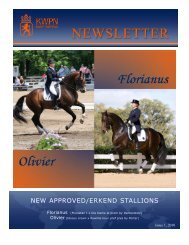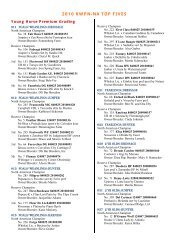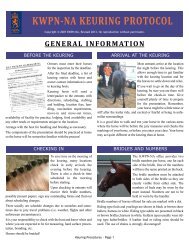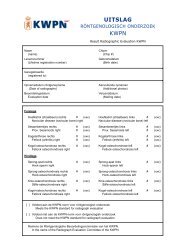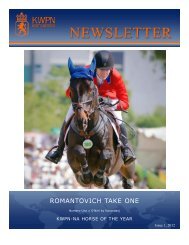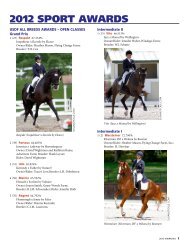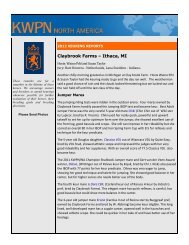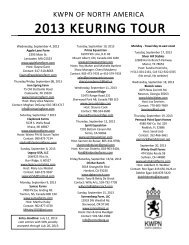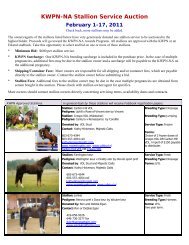Download PDF - KWPN
Download PDF - KWPN
Download PDF - KWPN
You also want an ePaper? Increase the reach of your titles
YUMPU automatically turns print PDFs into web optimized ePapers that Google loves.
ANNUAL MEETING - NUTRITION OF THE FOAL<br />
This is the second article on<br />
nutrition by Dr. Ott. The first<br />
article was on nutrition of the<br />
broodmare and was published<br />
in issue two of this newsletter.<br />
Dr. Ott is an Equine Nutrition<br />
Consultant and Professor<br />
Emeritus at the University of<br />
Florida<br />
by Edgar A. Ott, PhD<br />
The potential of the new foal is<br />
always the challenge that keeps the<br />
horse breeder breeding. It is exciting to<br />
see the colt running around its dam,<br />
playing with other foals of similar age<br />
and showing that he (she) is fastest,<br />
can jump highest, or turn quickest, for<br />
this is what life is about. However, a<br />
lot can go wrong between birth and the<br />
show ring, and some or maybe most<br />
of the things that go wrong are our<br />
responsibility.<br />
The suckling<br />
The foal has his greatest growth<br />
potential, that is rate of gain, during<br />
the first few months of life.<br />
Consequently, nutrient intake is critical.<br />
Under most circumstances the foal<br />
relies on it’s dam for most of its nutrient<br />
intake at birth and for several<br />
months. However, many foals will<br />
start eating dry feed within a week or<br />
so and will persist in consuming whatever<br />
is available to supplement<br />
mama’s milk. This will include, pasture,<br />
hay, the dam’s concentrate,<br />
manure and maybe soil. All of these<br />
items contribute to the nutrient intake<br />
of the foal. Some are better sources of<br />
nutrients than others. A pound of pasture,<br />
hay and concentrate does not<br />
contribute a significant amount of<br />
nutrients, but by the time the foal is<br />
three months of age that dry feed<br />
intake may approach three or four<br />
pounds per day and is now a significant<br />
portion of his intake. It is at this<br />
time that we need to start assuring that<br />
the concentrate portion of the diet is<br />
suitable for the foal.<br />
Mares’ milk contains about 3%<br />
protein during the first month of lactation<br />
and decreases to 2% as the lactation<br />
progresses. If the foal is getting 15<br />
kg of milk from it’s dam, the milk is<br />
providing 450 to 300 g of protein<br />
daily. At weaning time at 6 mo. of age,<br />
this foal will need 800 to 850 g of protein<br />
daily to sustain normal weight<br />
gain. He can’t get there with a concentrate<br />
providing 10% protein because<br />
he won’t eat 8.5 kg (18.7 lb) of concentrate<br />
daily at that age. As the dam’s<br />
milk production decreases the foal<br />
needs to have access to a creep feed<br />
providing 14 to16% protein. This will<br />
keep the protein intake adequate to<br />
sustain normal growth through the<br />
weaning process.<br />
Example 1<br />
Product<br />
Conc<br />
Oats<br />
50:50 Mix<br />
Protein<br />
16%<br />
12%<br />
14%<br />
Calcium<br />
0.65%<br />
0.05%<br />
0.35<br />
The weanling<br />
Weanlings need to be fed individually<br />
and should consume at least 1%<br />
BW of concentrate daily. Some may<br />
need more. Maximum growth rate is<br />
usually achieved at intakes of about<br />
1.7% of the Body Weight (BW) daily.<br />
However, maximum growth rates are<br />
not necessary for most warmbloods.<br />
The key is to provide a palatable product<br />
providing adequate energy, protein<br />
(14 - 16%), lysine, calcium, phosphorus,<br />
trace minerals and vitamins. The<br />
foal should also have access to all the<br />
high quality hay or pasture that he<br />
(she) will consume. If no pasture is<br />
available, this will be 1 to 1.5% BW of<br />
hay daily. Some flexibility is available<br />
on type of hay but an alfalfa/grass<br />
mixture is probably the best choice if it<br />
is available. The nutrient balance of<br />
the combination of the concentrate and<br />
the forage is particularly critical at this<br />
age and for best results select a commercial<br />
feed designed to be fed to the<br />
growing foal. Trying to formulate a<br />
concentrate yourself is wrought with<br />
many pit falls.<br />
The yearling<br />
Yearlings also need to be fed individually.<br />
The program is similar to the<br />
weanling except that the yearling will<br />
consume more feed. A slightly lower<br />
nutrient concentration in the concentrate<br />
may be appropriate. That is, if<br />
you feed the weanling a 16% protein<br />
concentrate the yearling will do fine<br />
Phos<br />
0.45%<br />
0.30%<br />
0.37%<br />
Zinc<br />
100 ppm<br />
20 ppm<br />
60 ppm<br />
Newsletter • Page 8



